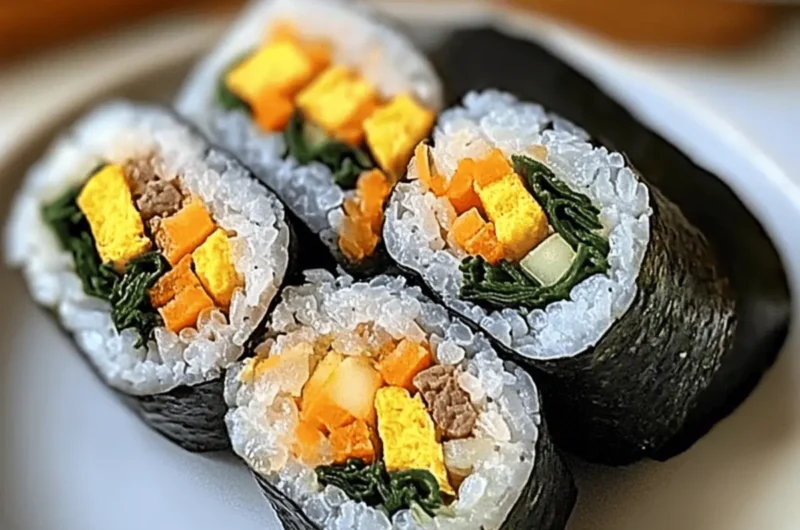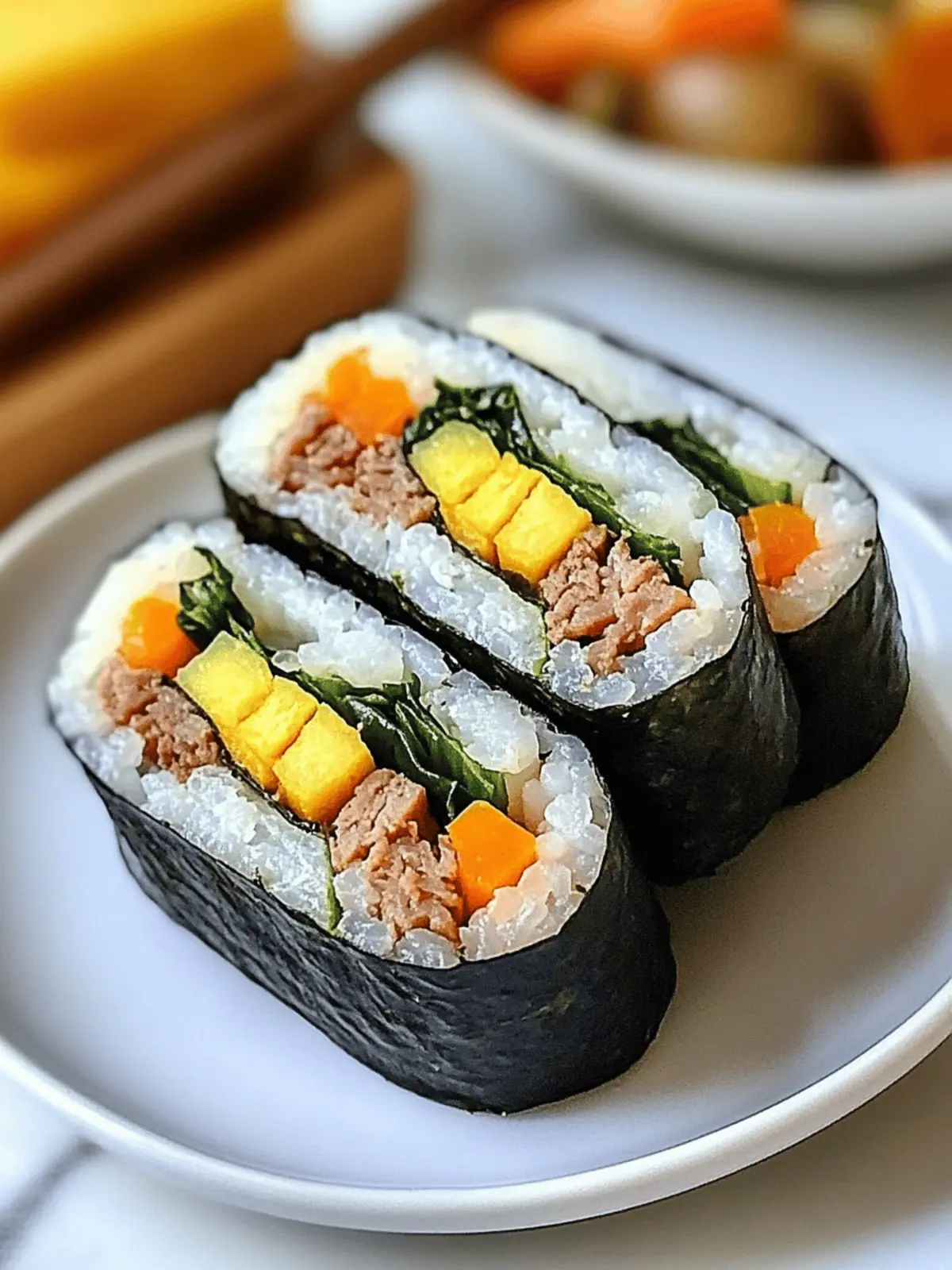When I first tasted Kimbap, it was like opening a treasure chest of flavors. The delightful aroma of sesame mingled with a hint of savory beef, and the fresh crunch of pickled radish brought a vibrant burst to every bite. This beloved Korean comfort food isn’t just a meal; it’s a heartwarming experience that wraps together everything I adore about home-cooked dishes. Each Kimbap roll is a canvas, inviting you to customize with colorful ingredients like tender spinach and sweet carrots, making it a perfect pick for a picnic or a cozy dinner at home.
Whether you’re revisiting a childhood favorite or stepping into the world of Korean cuisine for the first time, this recipe for Kimbap with Beef, Spinach, and Pickled Radish serves as a delightful gateway. It’s an easy-to-make dish buzzing with flavor and nostalgia, sure to impress both family and friends. So roll up your sleeves, grab your bamboo mat, and let’s dive into the joy of crafting these tasty rolls together!
Why is Kimbap with Beef, Spinach, and Pickled Radish a must-try?
Irresistible Flavor: Each bite of kimbap bursts with the rich, savory flavors of marinated beef, perfectly complemented by the fresh crunch of spinach and the tanginess of pickled radish.
Customizable Delight: This recipe allows for endless variations—from spicy kimchi to creamy cheese kimbap—catering to every palate.
Quick and Easy: With straightforward steps, you’ll have these colorful rolls ready in no time, making it a fabulous choice for busy weeknights or last-minute gatherings.
Visual Appeal: The vibrant colors of the ingredients create an eye-catching dish that feels celebratory, perfect for impressing guests.
Cultural Connection: Enjoying kimbap not only fills your belly but also connects you to a cherished Korean tradition, enriching your dining experience.
Perfect for Sharing: Whether for a picnic, lunchbox, or dinner, kimbap is easily shareable and loved by all, turning any meal into a joyful occasion.
Delicious Kimbap with Beef, Spinach, and Pickled Radish Ingredients
For the Beef Marinade
• Skirt Steak/Sirloin – Adds protein and rich flavor; can use tofu for a vegetarian option.
• Soy Sauce – Adds saltiness and depth; substitute with tamari for gluten-free.
• Rice Vinegar – Balances flavor with mild acidity; apple cider vinegar can be a great substitution.
• Sugar – Enhances the marinade and balances flavors; feel free to use honey or agave syrup instead.
• Garlic – Provides aromatic flavor; ensure it’s grated for even distribution.
For the Rice
• Medium-Grain White Rice – The base for the roll, providing texture; brown rice works well for a whole grain option.
• Sesame Oil – Adds a nutty flavor to rice; opt for light olive oil if you prefer a milder taste.
For the Veggies
• Spinach Leaves – Adds color, nutrients, and a fresh taste.
• Carrot – Provides sweetness and crunch; cut into thin matchsticks for even cooking.
• Danmuji (Yellow Pickled Radish) – A tangy component that adds crunch; consider quick-pickled cucumbers if needed.
For Assembly
• Gim (Roasted Seaweed/Nori) – Encasement for the ingredients.
• Small Bowl of Water – Used to seal the rolls.
Get ready to savor your homemade Kimbap with Beef, Spinach, and Pickled Radish, where each ingredient plays a vital role in delivering that unforgettable bite!
How to Make Kimbap with Beef, Spinach, and Pickled Radish
-
Marinate Beef: In a bowl, mix skirt steak with soy sauce, rice vinegar, sugar, and grated garlic. Allow it to marinate for at least 30 minutes to develop rich flavors.
-
Season Rice: Once the rice is cooked, drizzle it with sesame oil, and sprinkle a bit of salt. Stir gently and let it cool to room temperature.
-
Prepare Spinach: Blanch the spinach in boiling water for 15 seconds, then quickly cool it in ice water to maintain its vibrant color. Squeeze out any excess moisture and toss with sesame oil and salt.
-
Cook Carrots: Heat vegetable oil in a skillet over medium-high heat. Sauté the carrot matchsticks for about 1 minute, seasoning with a pinch of salt before removing from heat.
-
Cook Beef: In the same skillet, cook the marinated beef over medium heat until it’s fully cooked, roughly 4 minutes. Set it aside once done.
-
Assemble Kimbap: Lay a sheet of gim on a bamboo mat. Spread about 3/4 cup of seasoned rice evenly, leaving space at the top edge. Layer the cooked beef, spinach, sautéed carrots, and pickled radish in the center.
-
Roll & Seal: Gently lift the edge of the mat and start rolling it towards the top edge, pressing firmly but gently. Seal the roll by wetting the edge with a little water.
-
Slice & Serve: Brush the rolls with sesame oil to enhance flavor and prevent sticking. Using a sharp knife, slice into 6-8 pieces and serve them at room temperature.
Optional: Garnish with extra sesame seeds or serve with dipping sauce for added flavor.
Exact quantities are listed in the recipe card below.
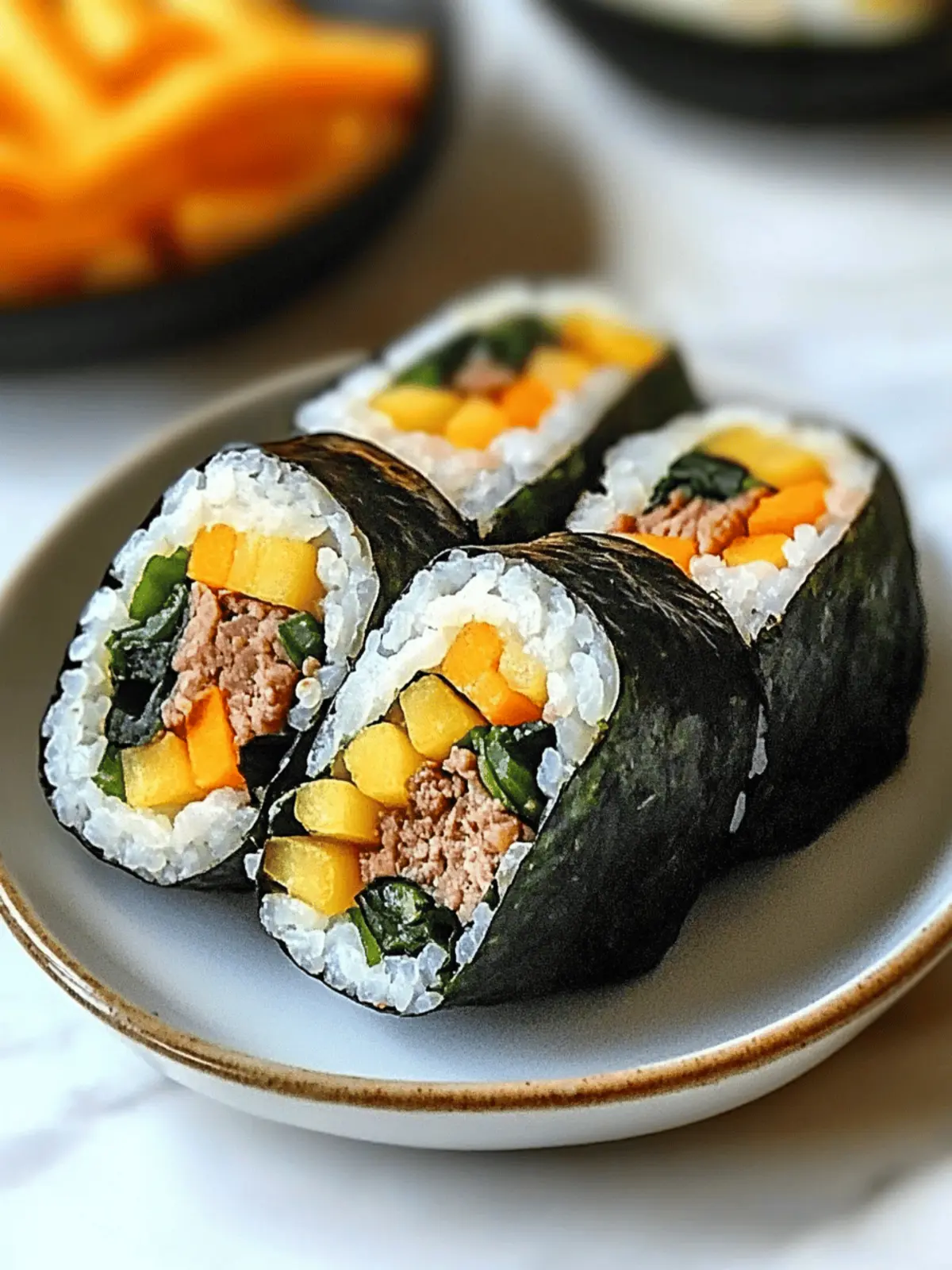
Kimbap with Beef, Spinach, and Pickled Radish Variations
Feel free to explore these fun and tasty variations that bring a personal touch to this wonderful dish!
-
Tuna Twist: Substitute beef with canned tuna mixed with a dash of mayonnaise for a creamy bite. This gives your kimbap a delightful seafood kick!
-
Kimchi Kick: Add sautéed kimchi for a zesty twist that’ll spice up each roll. It’s a perfect way to enjoy bold flavors while keeping it traditional.
-
Vegetarian Delight: Fill with an array of veggies like avocado, cucumber, and seasoned tofu for a vibrant vegetarian-friendly option. It’s colorful, nutritious, and totally satisfying!
-
Cheesy Pleasure: Incorporate some melted cheese slices for an extra layer of creaminess that kids will absolutely love. Think of it as a Korean twist on a classic grilled cheese!
-
Nude Kimbap: Roll with the rice on the outside, coated in sesame seeds, for a unique and visually appealing twist. It adds a delightful crunch to the traditional wrap.
-
Spicy Salmon: Replace the beef with thinly sliced spicy raw salmon for a luxurious sushi-style experience. Drizzle with a touch of sriracha for an added kick!
-
Avocado Bliss: Slip in creamy avocado slices among the veggies for a rich and buttery texture that harmonizes beautifully with the other ingredients.
-
Crispy Tempura: Add tempura-fried vegetables or shrimp for a delightful crunch that elevates the entire dish. This gives your kimbap a fabulous texture and flavor contrast!
Each variation opens up a world of flavors, inviting you to create a bountiful spread that’s sure to delight!
Expert Tips for Kimbap with Beef, Spinach, and Pickled Radish
- Use Sharp Knife: A sharp knife is essential for clean slices, ensuring each roll looks beautiful for serving.
- Cool the Rice: Let the rice cool slightly after seasoning to prevent tearing the nori while rolling.
- Practice Rolling: If you’re new to kimbap, try rolling with less filling at first to build your technique and confidence.
- Fresh is Best: Kimbap tastes its best when eaten the same day; refrigeration can affect the texture of the rice.
- Customize Wisely: Feel free to get creative with fillings, but avoid overstuffing to make rolling easier.
Make Ahead Options
These Kimbap with Beef, Spinach, and Pickled Radish are perfect for meal prep enthusiasts! You can marinate the beef up to 24 hours in advance, allowing the flavors to meld beautifully. Additionally, the rice can be seasoned and stored in the refrigerator for up to 3 days; just ensure it’s cooled completely before refrigerating to maintain texture. The spinach and carrots can also be blanched and sautéed ahead of time—store them in airtight containers, and they’ll keep fresh for up to 3 days. When you’re ready to serve, simply assemble the kimbap by rolling everything together, slice, and enjoy a delicious homemade meal with minimal effort!
How to Store and Freeze Kimbap with Beef, Spinach, and Pickled Radish
-
Room Temperature: Kimbap is best enjoyed fresh, but it can sit at room temperature for up to 2 hours before it starts to dry out.
-
Fridge: If you have leftovers, wrap them tightly in plastic wrap or place them in an airtight container, where they can last for up to 3 days.
-
Freezer: Kimbap can be frozen for up to 1 month, but it’s best to freeze it uncut. Wrap it tightly in plastic and foil to prevent freezer burn.
-
Reheating: For a deliciously crispy texture, pan-fry the kimbap slices in a little oil for 2-3 minutes on each side before serving.
What to Serve with Kimbap with Beef, Spinach, and Pickled Radish?
Pairing your kimbap with the right sides can elevate your meal to a delightful feast. Here are some delicious options to complement those vibrant rolls.
- Light Miso Soup: A warm, savory broth that adds depth and balances the flavors of the kimbap, creating a comforting and wholesome meal.
- Korean Kimchi: The spicy, tangy crunch of kimchi adds a lively contrast to the savory kimbap, making each bite a burst of flavor.
- Cucumber Salad: Light and refreshing, a simple cucumber salad tossed in rice vinegar enhances the freshness, highlighting the kimbap’s delightful ingredients.
- Sweet Potato Fries: Crispy, sweet potato fries offer a satisfying texture that contrasts beautifully with the soft kimbap, making for a delightful munch.
- Tteokbokki (Spicy Rice Cakes): Chewy rice cakes in a spicy sauce add both heat and heartiness to your meal, enticing the palate with every bite.
- Fruity Soju Cocktail: Enjoy a light, fruity cocktail to refresh your palate and provide a fun twist to your meal, enhancing the overall dining experience.
- Korean BBQ Meat: A side of grilled beef or pork can complement the savory layers of the kimbap, turning your meal into a full Korean feast.
- Seasoned Seaweed Snack: Crunchy seaweed strips provide a delightful texture, perfectly mirroring the umami flavors of your kimbap, making for a delightful nibble.
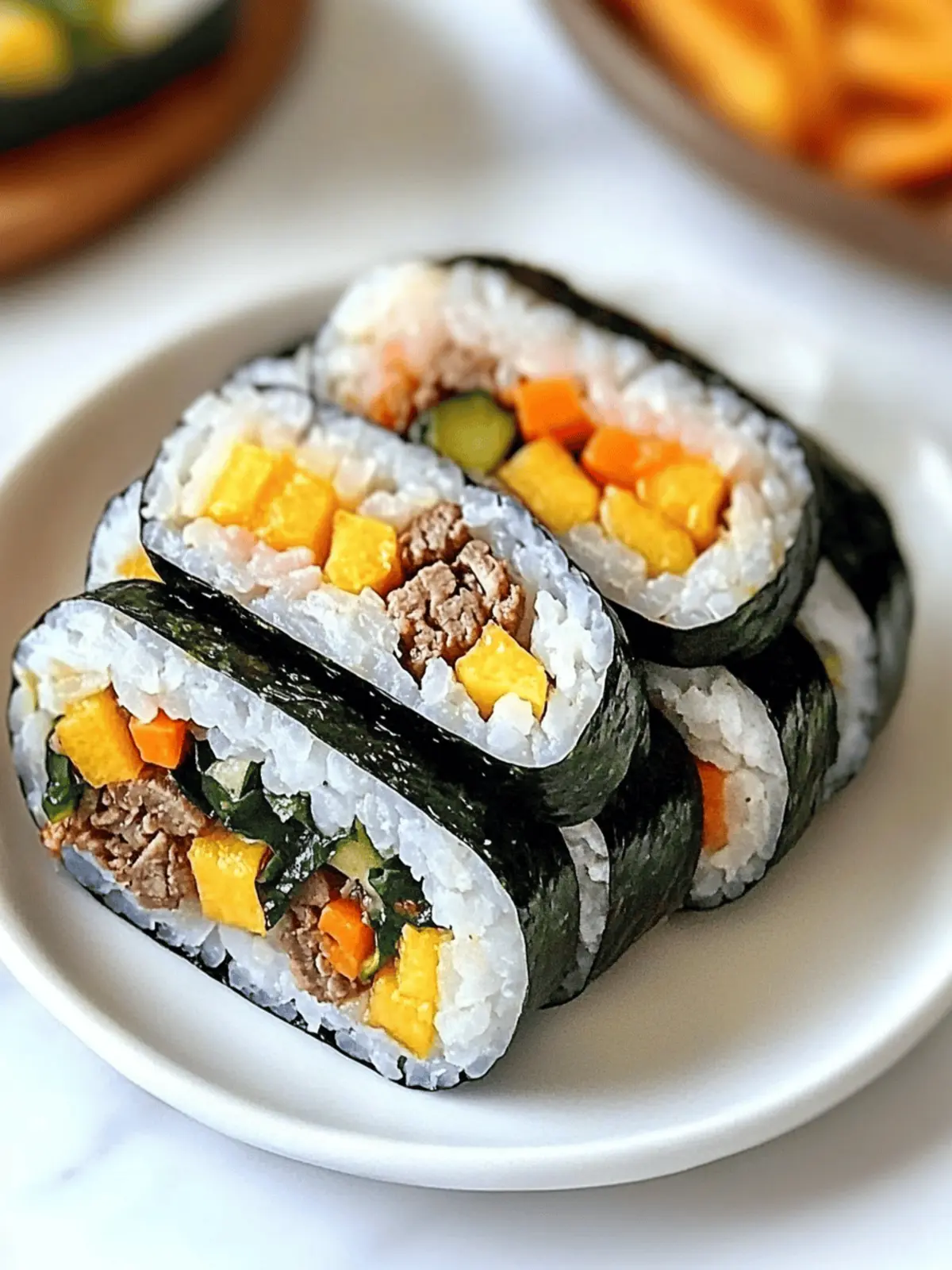
Kimbap with Beef, Spinach, and Pickled Radish Recipe FAQs
How do I choose the right beef for kimbap?
Absolutely! For kimbap, I recommend using skirt steak or sirloin as they are flavorful and tender when cooked. Look for cuts that are bright red with minimal fat marbling. If you’re going for a vegetarian option, tofu works as an excellent substitute, offering a satisfying texture without compromising flavor.
How should I store leftover kimbap?
To store leftover kimbap, wrap it tightly in plastic wrap or place it in an airtight container to keep it from drying out. It can last in the fridge for up to 3 days. For the best texture, enjoy it fresh—refrigerated kimbap may become a little less satisfying.
Can I freeze kimbap?
Yes, you can! To freeze kimbap, wrap the rolls tightly in plastic wrap and then in foil to prevent freezer burn. They can be frozen for up to 1 month. When you’re ready to enjoy your kimbap, I suggest reheating it by pan-frying the slices in a little oil, about 2-3 minutes per side, for a delightful crispy texture.
What should I do if my kimbap is falling apart when rolling?
If your kimbap is falling apart, it typically helps to avoid overstuffing the roll. Start with smaller amounts of filling—about 1/4 cup of rice and a few ingredients—until you get the hang of it. Additionally, make sure your rice is slightly cooled and sticky; this helps it hold together better. Practice makes perfect, so don’t worry if the first few rolls aren’t perfect!
Is kimbap safe for pets or allergies?
Kimbap is generally safe for dogs in small amounts, but the soy sauce can be too salty, so be cautious. Avoid giving kimbap to pets that have allergies to common ingredients like soy or garlic. If you’re making it for someone with dietary restrictions, be sure to check for any specific allergies, especially with ingredients like sesame oil or pickled radish, which can be high in sodium.
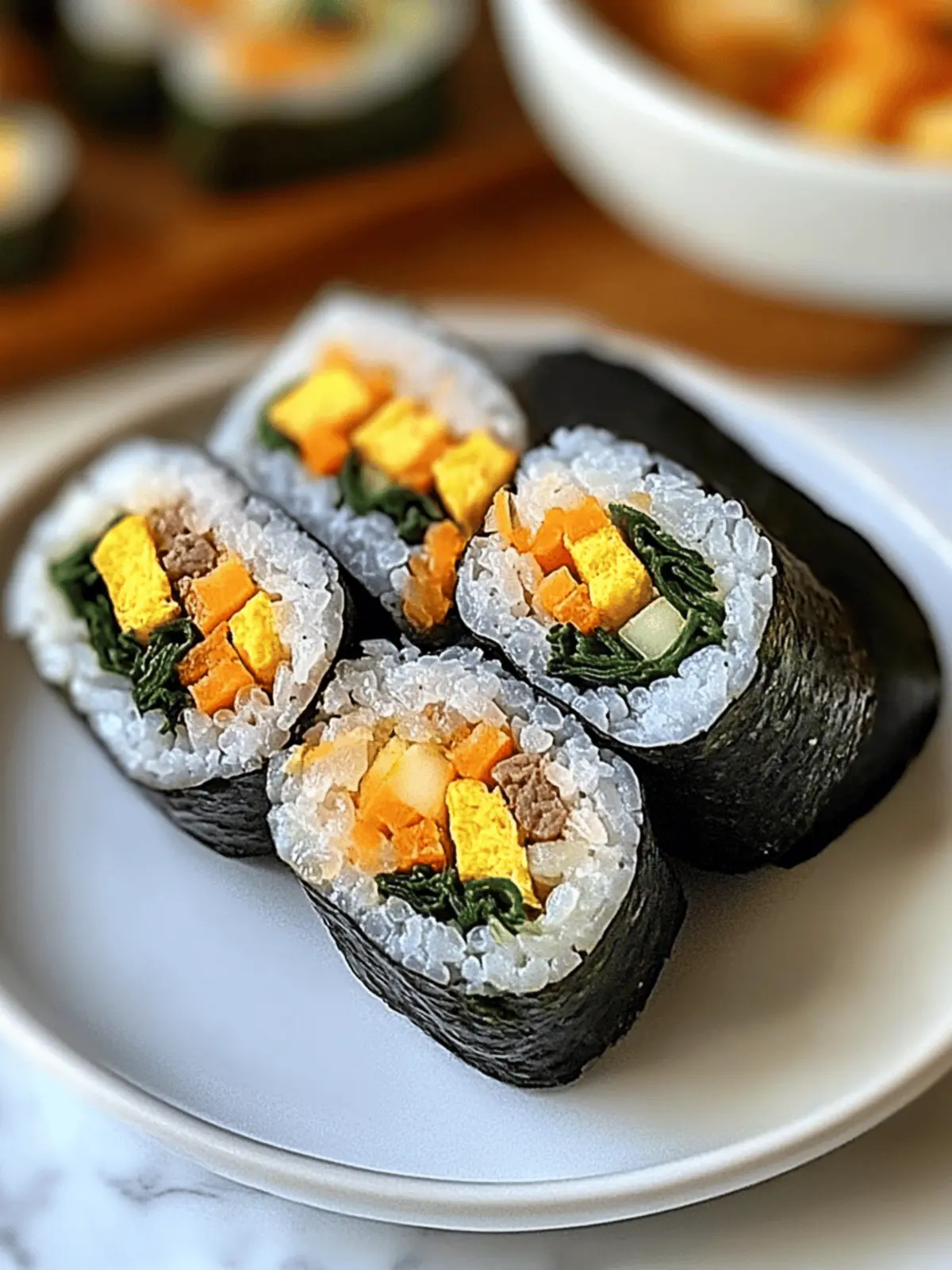
Savor Kimbap with Beef, Spinach, and Pickled Radish Bliss
Ingredients
Equipment
Method
- Marinate the beef by mixing skirt steak with soy sauce, rice vinegar, sugar, and grated garlic. Allow it to marinate for at least 30 minutes.
- Once the rice is cooked, drizzle it with sesame oil and sprinkle a bit of salt. Stir gently and let it cool to room temperature.
- Blanch the spinach in boiling water for 15 seconds, then cool it quickly in ice water. Squeeze out excess moisture and toss with sesame oil and salt.
- Heat vegetable oil in a skillet over medium-high heat. Sauté the carrot matchsticks for about 1 minute, adding a pinch of salt.
- In the same skillet, cook the marinated beef over medium heat until fully cooked, roughly 4 minutes. Set aside.
- Lay a sheet of gim on a bamboo mat. Spread about 3/4 cup of seasoned rice evenly, leaving space at the top edge. Layer cooked beef, spinach, sautéed carrots, and pickled radish in the center.
- Gently lift the edge of the mat and start rolling towards the top edge, pressing firmly but gently. Seal the roll by wetting the edge with a little water.
- Brush the rolls with sesame oil to enhance flavor. Slice into 6-8 pieces and serve at room temperature.

